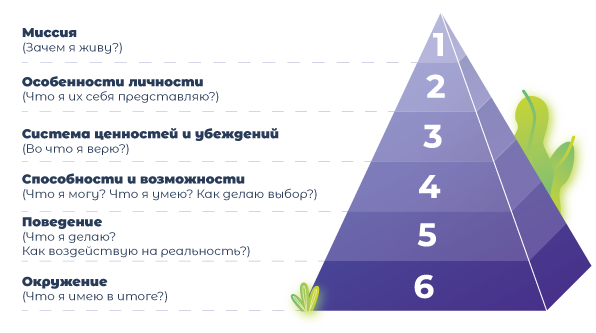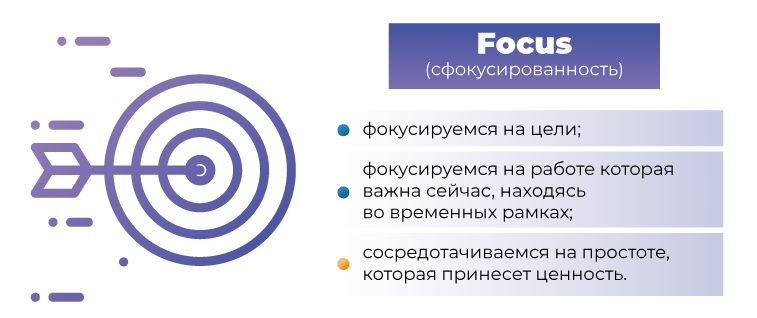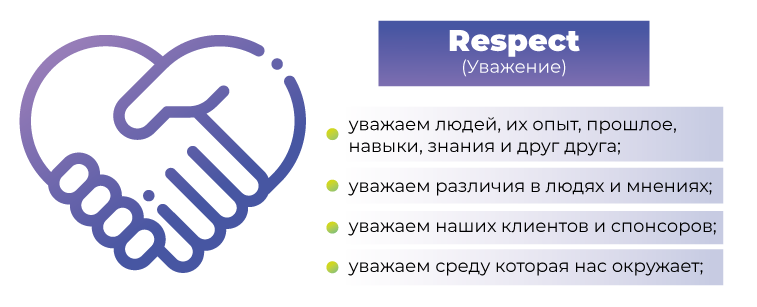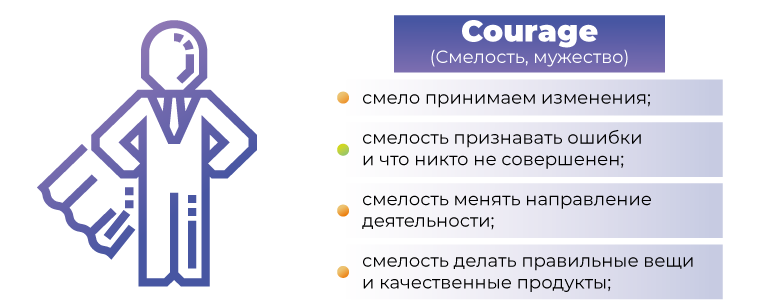Scrum and Graves' spiral dynamics: how not to fly on reefs
Everyone who is at least a little familiar with Scrum surely knows his three short characteristics:
Working as a Scrum Master at Hubber, I constantly discover new facets of the latest feature.

The Scrum Guide contains a paragraph where values are listed - involvement, focus, openness, respect, courage. To quote the greats - “The success of using Scrum depends on how well people adhere to these values . ”
')
I agree that these values are one of those facets that make Scrum difficult to master in perfection. Let's see why.
Let us turn to the model of “neurological levels” of Robert Dilts . In the people - the Pyramid of Dilts.

Dilts placed valuables on the third level. There is a certain logic in this simple pyramid - higher levels define lower ones. For example:
There is one important focus in this pyramid. Any changes at higher levels lead to changes at lower levels.
For example: we leave the mission the same, change the second level to - Super Planter . And bang - everything changes below. Or change the values to: “I believe that many people drink coffee. Coffee business is profitable . ” And again will change the ability, behavior and environment. Everything will focus on profit, not on people (as in the first case).
In this sense, Sutherland and Schwaber (creators of Scrum) along with the framework give excellent values (engagement, focus, openness, respect, courage). Accepting these values, we must qualitatively change the ability, behavior and environment in a team or organization as a whole. Where are the difficulties, you ask? And here they are!
In neuro-linguistic programming there is a concept - a complex equivalent. These are the same values. That is, value is a noun that is a label for a set of actions and experiences (verbs). And everything would be fine, only for each value in the form of a noun, each individual has his own set of verbs.
For example:
Both have a “Respect” Value. Just showing it to each other, they will get at best a misunderstanding, at worst - a conflict. At the company level, the same story. In addition, in most cases, employees are not aware of the set of verbs that stands behind the beautiful nouns, invented by business owners.
Tablet. Maximize your Skram values and your own. Explain to everyone what you expect from your colleagues when they show these values. Broadcast values in your actions. Try on successful (and not so) case studies to values - which one worked here, and which one you forgot about.
Here we turn to the Claire Graves “Spiral Dynamics” model of human values. If Scrum is easy to understand, but difficult to master, then with Spiral Dynamics and with understanding is not easy.
However, this is a very effective model for diagnosing the stages of development of an individual, organization, society, and humanity as a whole. By the way, Frédéric Lalue invented his “Turquoise Organizations”, based precisely on this model.
Graves argues that we all develop in a spiral, and identifies 8 levels (there is still the 9th coral, but so far it has not been practically described).

Each level has its own values, which are shown in the figure, and it shows what moves us on one level or another. Important: each next level includes the previous one. Levels depend on living conditions, i.e. on the environment and context.
A spoiled kid of rich parents falls into the orange living conditions and accepts the values of this level - success and ambition. And everything seems to have already happened, but, getting into the red conditions of life, the kid can not stand up for himself and gets cuffs, does not get the position, can not protect the business and loses it.
An orange or yellow organization with an undeveloped purple level (security and tradition) can constantly struggle with turnover and lack of innovation.
It can be concluded that the helix must be solid from the very foundation, so that when entering a different environment and contexts, a person or a company can effectively cope with actual problems based on their values.
Let's try to impose the values of Scrum on the Graves spiral and see at what levels these five values lie. But first, we will decompose these beautiful nouns into more specific actions.





As you see, Openness and Respect are all on the Green Level. The features of this level are:
Orange is in second place in terms of quantity, and this is not at all strange - all the same, Scrum is used in business to a greater degree. I want to note that a strong orange can only be on the foundation of a strong Red Level, that is, Strength and Power. Here are the features:
In the third place is the Blue Level of laws, rules and the rule of supreme truth and purpose. Skram also has procedures like structure and purpose, although many confuse flexibility with total chaos. Features at this level:
As you can see, Scrum's values are high enough in the Graves spiral. In the IT industry, many colleagues are already reaching for orange and less for green. Organizations, often at the orange level, interact with the state and competitors more at the blue and red levels.
Do you remember the Dilts Pyramid and focus on changing at a certain level? It really works, but the problem is that the higher the level, the harder it is to change it. This is quite a long and energy-intensive process.
Tablet. Select people by values, not just technical skills. Detail soft-skills and try on all candidates. Selecting people by values, you will already form them in the organization. Create the “Living Conditions” (environment) of the level you want to achieve, and people will learn new values and make them organizational.
The success of using Scrum directly depends on how well people adhere to these values. (Scrum Guide, 2017).
The values of people and organizations are the driving force and goal. They are like the wind in the sails of a ship and like a beacon to which this ship goes. And if you treat them simply as with beautiful nouns, then you can endlessly hang out in calmness and end up flying into reefs.
- compact;
- easy to understand;
- difficult to master perfectly.
Working as a Scrum Master at Hubber, I constantly discover new facets of the latest feature.

The Scrum Guide contains a paragraph where values are listed - involvement, focus, openness, respect, courage. To quote the greats - “The success of using Scrum depends on how well people adhere to these values . ”
')
I agree that these values are one of those facets that make Scrum difficult to master in perfection. Let's see why.
Neurological levels
Let us turn to the model of “neurological levels” of Robert Dilts . In the people - the Pyramid of Dilts.

Dilts placed valuables on the third level. There is a certain logic in this simple pyramid - higher levels define lower ones. For example:
- My mission (necessarily unattainable, this is the mission!): So that all people in the world should drink only high-quality natural coffee;
- Who I am: I am the Great Barista.
- Values (what I believe): I believe that high-quality coffee gives people vigor, contributes to a pleasant communication and productivity.
- What I can do: I have a great understanding of coffee, I know how to buy it and cook delicious.
- What I do: I make coffee, talk to interesting people every day.
- What I have in the end: I have 2 coffee shops in cozy parks, several coffee machines, 5 employees, many soft comfortable poufs, pleasant music in coffee shops.
There is one important focus in this pyramid. Any changes at higher levels lead to changes at lower levels.
For example: we leave the mission the same, change the second level to - Super Planter . And bang - everything changes below. Or change the values to: “I believe that many people drink coffee. Coffee business is profitable . ” And again will change the ability, behavior and environment. Everything will focus on profit, not on people (as in the first case).
In this sense, Sutherland and Schwaber (creators of Scrum) along with the framework give excellent values (engagement, focus, openness, respect, courage). Accepting these values, we must qualitatively change the ability, behavior and environment in a team or organization as a whole. Where are the difficulties, you ask? And here they are!
Difficulty number 1 - misunderstanding
In neuro-linguistic programming there is a concept - a complex equivalent. These are the same values. That is, value is a noun that is a label for a set of actions and experiences (verbs). And everything would be fine, only for each value in the form of a noun, each individual has his own set of verbs.
For example:
- The 1st person, under “Respect”, means “To give advice, to constantly offer our help, to come to meetings on time, not to criticize colleagues”.
- The 2nd person understands the opposite - “Criticize colleagues whom you respect (so that they become better), help and advise only if asked, make decisions together.
Both have a “Respect” Value. Just showing it to each other, they will get at best a misunderstanding, at worst - a conflict. At the company level, the same story. In addition, in most cases, employees are not aware of the set of verbs that stands behind the beautiful nouns, invented by business owners.
Tablet. Maximize your Skram values and your own. Explain to everyone what you expect from your colleagues when they show these values. Broadcast values in your actions. Try on successful (and not so) case studies to values - which one worked here, and which one you forgot about.
Difficulty number 2 - fragility
Here we turn to the Claire Graves “Spiral Dynamics” model of human values. If Scrum is easy to understand, but difficult to master, then with Spiral Dynamics and with understanding is not easy.
However, this is a very effective model for diagnosing the stages of development of an individual, organization, society, and humanity as a whole. By the way, Frédéric Lalue invented his “Turquoise Organizations”, based precisely on this model.
Graves argues that we all develop in a spiral, and identifies 8 levels (there is still the 9th coral, but so far it has not been practically described).

Each level has its own values, which are shown in the figure, and it shows what moves us on one level or another. Important: each next level includes the previous one. Levels depend on living conditions, i.e. on the environment and context.
A spoiled kid of rich parents falls into the orange living conditions and accepts the values of this level - success and ambition. And everything seems to have already happened, but, getting into the red conditions of life, the kid can not stand up for himself and gets cuffs, does not get the position, can not protect the business and loses it.
An orange or yellow organization with an undeveloped purple level (security and tradition) can constantly struggle with turnover and lack of innovation.
It can be concluded that the helix must be solid from the very foundation, so that when entering a different environment and contexts, a person or a company can effectively cope with actual problems based on their values.
Let's try to impose the values of Scrum on the Graves spiral and see at what levels these five values lie. But first, we will decompose these beautiful nouns into more specific actions.





As you see, Openness and Respect are all on the Green Level. The features of this level are:
- Connections between people;
- Formation of an environmentally friendly environment;
- Right to make mistakes;
- Learning takes place through observation and empiricism.
- Openness both within the community and with the external environment (partners, customers).
Orange is in second place in terms of quantity, and this is not at all strange - all the same, Scrum is used in business to a greater degree. I want to note that a strong orange can only be on the foundation of a strong Red Level, that is, Strength and Power. Here are the features:
- Learning by experiment, through trial and error;
- There are engineers and entrepreneurs;
- Desire for independence;
- Improving life through science and technology;
- Prestige matters.
In the third place is the Blue Level of laws, rules and the rule of supreme truth and purpose. Skram also has procedures like structure and purpose, although many confuse flexibility with total chaos. Features at this level:
- Following the meaning and purpose;
- Order instead of anarchy;
- Consistency and rules;
- Systematization
As you can see, Scrum's values are high enough in the Graves spiral. In the IT industry, many colleagues are already reaching for orange and less for green. Organizations, often at the orange level, interact with the state and competitors more at the blue and red levels.
Do you remember the Dilts Pyramid and focus on changing at a certain level? It really works, but the problem is that the higher the level, the harder it is to change it. This is quite a long and energy-intensive process.
Tablet. Select people by values, not just technical skills. Detail soft-skills and try on all candidates. Selecting people by values, you will already form them in the organization. Create the “Living Conditions” (environment) of the level you want to achieve, and people will learn new values and make them organizational.
The success of using Scrum directly depends on how well people adhere to these values. (Scrum Guide, 2017).
The values of people and organizations are the driving force and goal. They are like the wind in the sails of a ship and like a beacon to which this ship goes. And if you treat them simply as with beautiful nouns, then you can endlessly hang out in calmness and end up flying into reefs.
Source: https://habr.com/ru/post/441198/
All Articles